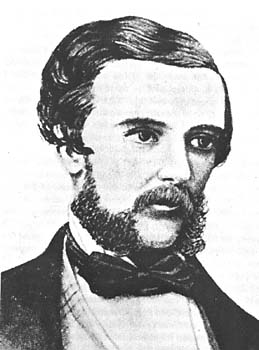
Council of Heads of Australasian Herbaria
Australian National Herbarium
Biographical Notes
 |
Council of Heads of Australasian Herbaria |
 Kennedy,
Edmund Besley Court (1818 - 1848)
Kennedy,
Edmund Besley Court (1818 - 1848)Born on 5 September 1818 on Guernsey, Channel Islands; died near Escape River in far north Queensland near Cape York, in December 1848 "in the arms of the devoted Aboriginal guide Jackey Jackey".
Born on Guernsey, Channel Islands in 1818, he embarked for Australia, arriving in Sydney in 1840, and while still only 21 was appointed an assistant surveyor in the Surveyor-General's Department.
He began duty on 7 August 1840 and immediately left under Charles Tyers for the Portland Bay settlement in western Victoria. In 1841 he began general survey work there.
After his return to Sydney on 12 June 1843 his duties were slight; because of the falling off in land sales, most of the surveyors were on half-pay, and Kennedy had practically nothing to do for over two years. He did, however, establish himself as a popular and charming member of society, with a rowdy, boyish sense of fun. His gifts included a pleasant singing voice and considerable skill in sketching in pencil and water-colour.
In November 1845 he was suddenly appointed second-in-command, under Sir Thomas Mitchell, of the expedition to find an overland route to the Gulf of Carpentaria. Under this leader Kennedy was kept somewhat in the background, but after minor initial criticisms Mitchell praised his 'temperate and gentlemanly way, and highly honourable principles', with frequent references to his zeal and activity. The party returned to Sydney in January 1847.
Mitchell felt convinced that his 'Victoria' River flowed into the gulf, but his theory had to be tested, and Kennedy volunteered to lead an expedition to do so.
With a small party of eight men and an Aboriginal boy, he left Sydney on 13 March 1847, retraced the tracks of Mitchell to his farthest point on the 'Victoria', and followed it down its course, only to find that instead of flowing north-west to the gulf it flowed south-west to become part of Cooper's Creek. He renamed the 'Victoria' the Barcoo, and discovered and named the Thomson River. He then traced the Warrego River down until its waters gave out, whereupon he crossed south-east to the Culgoa, and thence back to Sydney, arriving on 7 February 1848.
Within a few months he was again in the field, this time on an ambitious plan of landing at Rockingham Bay to traverse Cape York Peninsula along the east coast to its most northerly point, where supplies would be replenished from a ship waiting at Albany Passage.
After a series of mishaps, on 13 November Kennedy decided to leave eight of his thirteen men at Weymouth Bay while he and four others made forced marches to the supply ship for help. After more mishaps he and the Aboriginal boy, Jackey Jackey, pressed on alone. With weakening strength but superb courage and endurance, they reached to within about twenty miles (32 km) of the supply ship, only to find themselves trapped by the Escape River and its crocodile-infested mangrove swamps. In the second week of December Aboriginals, who had become increasingly hostile, attacked; Kennedy was speared and soon afterwards died in the arms of the devoted Jackey Jackey, who alone reached the ship and was saved.
Kennedy died unmarried.
As an artist he contributed a drawing to T.L.Mitchell, Three
Expeditions into the interior of eastern Australia (1838).
Source:
https://adb.anu.edu.au/biography/kennedy-edmund-besley-2297
H.Hewson Australia - 300 Years of Botanical Illustration
(1999)